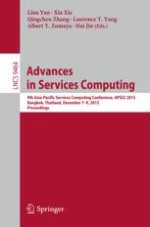2015 | Book
Advances in Services Computing
9th Asia-Pacific Services Computing Conference, APSCC 2015, Bangkok, Thailand, December 7-9, 2015, Proceedings
Editors: Lina Yao, Xia Xie, Qingchen Zhang, Laurence T. Yang, Albert Y. Zomaya, Hai Jin
Publisher: Springer International Publishing
Book Series : Lecture Notes in Computer Science
